This article was medically reviewed by Luxme Hariharan, MD, MPH. Dr. Luxme Hariharan is a Board Certified Pediatric Ophthalmologist. She currently is a Pediatric Ophthalmologist at Nicklaus Children's Hospital in Miami, Florida. She specializes in pediatric ophthalmology and preventing childhood blindness. Dr. Hariharan has worked with global institutions including the World Health Organization, the American Academy of Ophthalmology, Orbis, and Sightlife. She holds a BS in Biology and Latin American, Caribbean & Iberian Studies from The University of Wisconsin-Madison, a Masters of Public Health (MPH) in International Health, Child Health, Epidemiology & Biostatistics from Johns Hopkins University, and an MD from The University of Wisconsin-Madison. She is a member and serves on several committees within the American Academy of Ophthalmology, The American Academy of Pediatric Ophthalmology and Strabismus; and sits on the board of directors of Combat Blindness International.
There are 15 references cited in this article, which can be found at the bottom of the page.
This article has been viewed 52,220 times.
There are various types of eye ointments that treat a range of conditions, and they’re all easy to use. Antibiotic ointments and medications for conditions such as dry eyes are applied inside the lower eyelid. If you have eczema on your eyelids, you might need to apply a special topical ointment to the sensitive skin around your eyes. When applying any type of ointment, wash your hands before and after applying it.[1] If you have an eye condition, talk to your doctor about the best way to treat it.
Steps
Applying Ointment Inside the Lower Eyelid
-
1Wash your hands before and after applying ointment. Wash your hands with soap and hot water for 30 seconds before handling and applying the ointment. Whether you’re applying it to your own eyes or helping someone else, wash your hands after you’re finished, too.[2]
- If you're treating an eye infection, washing your hands will help prevent spreading it. Even if you don't have an infection, wash your hands before touching your eyes. You wouldn't want to get germs or dirt in them.
-
2Warm the tube with your hand and remove the cap. Hold the capped tube of ointment in your closed hand for a few seconds to warm it. Warming the ointment will help it flow more easily. Then take the cap off of the tube and store it on its side on a clean surface.[3]
- That way, the cap won’t roll onto the floor or get lost. Placing it on a clean tissue is a good option.
Advertisement -
3Press your thumb to the skin beneath the lower eyelid. Tilt your head back or, if you’re applying ointment to another person’s eyes, have them tilt their head.[4] Hold 1 finger at the eyebrow, and use your thumb to carefully press the skin just below the lower eyelid. Using gentle pressure, pull the skin down to expose the pocket between the eye and lower lid.[5]
- The pocket is the pink (or red, if you’re treating an eye infection) area around the eyeball.
-
4Apply a thin strip of ointment between the eye and lower lid. Hold the tip of the tube about 1 inch (2.5 cm) from the eye. Starting from the corner closest to the nose, spread a strip of ointment about 1⁄3 inch (0.85 cm) thick (or the recommended amount) across the space between the eye and lower lid. If necessary, repeat the steps on the other eye.[6]
- Rotate the tube when you’ve finished spreading the strip. This will help detach the strip of ointment from the tip of the tube.[7]
- A thin strip across the inside of the lower eyelid is a general dosage guideline, but the recommended dosage can vary. If your doctor or pharmacist advises a different dosage, go with their instructions.
-
5Cap the tube and keep your eyes closed for 2 minutes. After you apply the ointment, close your eyes and wipe away excess ointment with a clean tissue.[8] If necessary, wipe excess ointment off the tip of the tube with another clean tissue (not the one you used to wipe your eye). Cap the tube promptly, and don’t let the tip touch any surfaces other than the clean tissue.[9]
- If you’re applying ointment to your own eyes, you might have trouble seeing what you’re doing. Have someone help you or wait to cap the tube until you can open your eyes. Just don’t let the tip of the tube touch any surfaces other than a clean tissue in the meantime.
- Remember to wash your hands after applying the ointment.
- Apply ointment as many times per day as your doctor or pharmacist advises.[10]
-
6Try to relax and ask for help if you can't keep from blinking. If you can't stop blinking, you might not be able to get the ointment inside your eyelids. Try your best to hold them open with your thumb and index finger. If you have no luck, ask someone to help you hold your eyelids open and apply the ointment.
- It can be tough to stop blinking when the tube is close to your eye and you feel the strange sensation of the ointment. Try to relax and remind yourself that the medicine will help you feel better.
- It's a little easier to apply an accurate dose of eye ointment than it is to use eye drops, which are easily washed away if you blink a lot.
-
7Hold a young child in a blanket if you're applying ointment to their eyes. You might run into a little difficulty when applying ointment to a squirmy young child’s eyes. To make things easier, wrap them in a blanket so you can gently keep their arms under control.[11]
- If possible, enlist a helper to hold your baby or young child while you apply the ointment.
Applying Ointment to the Eyelids
-
1Wash your hands before and after using a topical ointment. You’ll apply a topical ointment with your fingers, so clean hands are a must. Wash your hands with soap and hot water thoroughly before touching your eyes, then wash them again after to get rid of residual ointment.[12]
- Your hands should be clean before touching irritated skin in order to prevent an infection.
-
2Use the smallest possible amount to thinly cover the affected area. Remove the tube’s cap and store it in a safe, sanitary place, like on a clean tissue. Squeeze a tiny dab onto your fingertip and gently massage it onto the affected area. Use only enough ointment to thinly cover the affected skin, and massage it until it’s completely absorbed.[13]
- Be careful not to get any ointment inside your eyes.
- Only apply a topical ointment to dry skin. Don’t apply the ointment to areas of skin that aren’t affected by the condition you are treating.
-
3Don’t bathe or swim right after applying the ointment. Don’t wash your face, take a shower, or go swimming for at least 30 minutes. Exposing the area to water immediately after applying ointment could wash away the medication before it can take effect.[14]
-
4Avoid direct sunlight, tanning beds, and other sources of UV light. Wear sunglasses when you go outside, even if it’s been hours since you applied the medication. Ointments used to treat conditions such as eczema around the eyelids can cause sensitivity to sunlight.[15]
- Try to keep the affected area out of direct sunlight for as long as you use the medication.
-
5Use the ointment for up to 6 weeks. Apply the ointment twice a day for as long as you have symptoms, or according to your dermatologist’s instructions. Ointments prescribed for eyelid eczema should be used for less than 6 weeks. Don’t use your medication for a longer period without your doctor’s advisement.[16]
Consulting a Medical Professional
-
1
-
2Discuss ointments that relieve dry eyes with your eye doctor. If you suffer from dry eyes, your doctor might recommend an ointment or gel. Ointments and gels are recommended over eye drops for patients who usually experience dry eyes in the morning.[19]
- Sometimes your eyes open slightly while you sleep, which can cause eye drops to evaporate. Thicker ointments and gels can last through the night without evaporating.
-
3Ask your dermatologist about treating eczema with a calcineurin inhibitor. Many ointments and creams used to treat eczema can’t be used on your face, since they can cause skin to become thinner or irritate sensitive areas. Calcineurin inhibitors don’t cause skin thinning, so they’re often recommended to treat eczema on the eyelids and other areas with thin, sensitive skin.[20]
-
4Tell your doctor about any other medications you take. To avoid potentially harmful drug interactions, tell your doctor about any prescriptions you take regularly. Additionally, let your doctor know if you take any herbs or supplements, drink alcohol, or use drugs.[21]
-
5Don’t stop using an antibiotic without asking your doctor. It’s best to check with your doctor before you stop taking any medication. It’s especially important to take antibiotics for the full duration of time your doctor prescribes.[22]
- Your doctor might just tell you to stop using a topical ointment when your eczema clears.
-
6Call your doctor if you experience side effects or if your symptoms worsen.[23] Side effects depend on the type of ointment you’re using, but could include burning, redness, pain, and skin discoloration. If your symptoms don’t improve or get worse, call your doctor to schedule a follow up appointment.[24]
- An infection should start to clear up after a couple of days. Dry eyes and eczema can take longer to treat, so ask your doctor when you should expect symptoms to improve.
Expert Q&A
-
QuestionHow do I put ointment on my stye? Its on my upper eye lid.
 Sarah Gehrke, RN, MSSarah Gehrke is a Registered Nurse and Licensed Massage Therapist in Texas. Sarah has over 10 years of experience teaching and practicing phlebotomy and intravenous (IV) therapy using physical, psychological, and emotional support. She received her Massage Therapist License from the Amarillo Massage Therapy Institute in 2008 and a M.S. in Nursing from the University of Phoenix in 2013.
Sarah Gehrke, RN, MSSarah Gehrke is a Registered Nurse and Licensed Massage Therapist in Texas. Sarah has over 10 years of experience teaching and practicing phlebotomy and intravenous (IV) therapy using physical, psychological, and emotional support. She received her Massage Therapist License from the Amarillo Massage Therapy Institute in 2008 and a M.S. in Nursing from the University of Phoenix in 2013.
Registered Nurse First, wash the eye with warm water and lightly pat it dry. Then, with clean hands, apply the advised ointment directly to your stye. Styes respond well to warm (not hot) compresses. You can apply the compress for 5 to 10 min before you apply the ointment.
First, wash the eye with warm water and lightly pat it dry. Then, with clean hands, apply the advised ointment directly to your stye. Styes respond well to warm (not hot) compresses. You can apply the compress for 5 to 10 min before you apply the ointment.
References
- ↑ Luxme Hariharan, MD, MPH. Board Certified Ophthalmologist. Expert Interview. 17 August 2021.
- ↑ https://www.aboutkidshealth.ca/Article?contentid=996&language=English
- ↑ https://www.aboutkidshealth.ca/Article?contentid=996&language=English
- ↑ Luxme Hariharan, MD, MPH. Board Certified Ophthalmologist. Expert Interview. 17 August 2021.
- ↑ https://www.aboutkidshealth.ca/article?contentid=996&language=english
- ↑ https://www.healthychildren.org/English/safety-prevention/at-home/medication-safety/Pages/How-to-Give-Eye-Drops-and-Eye-Ointment.aspx
- ↑ https://www.healthychildren.org/English/safety-prevention/at-home/medication-safety/Pages/How-to-Give-Eye-Drops-and-Eye-Ointment.aspx
- ↑ Luxme Hariharan, MD, MPH. Board Certified Ophthalmologist. Expert Interview. 17 August 2021.
- ↑ https://www.aao.org/eye-health/treatments/how-to-put-in-eye-drops
- ↑ https://www.mayoclinic.org/drugs-supplements/erythromycin-ophthalmic-route/proper-use/drg-20068673
- ↑ https://www.ncbi.nlm.nih.gov/pmc/articles/PMC2873669/
- ↑ https://glaucoma.org/learn-about-glaucoma/patient-resources/how-to-use-eye-drops/
- ↑ https://my.clevelandclinic.org/health/drugs/19501-erythromycin-eye-ointment
- ↑ https://www.fda.gov/downloads/Drugs/DrugSafety/PostmarketDrugSafetyInformationforPatientsandProviders/ucm107848.pdf
- ↑ https://nationaleczema.org/eczema/treatment/topicals/
- ↑ https://eczema.org/information-and-advice/types-of-eczema/eczema-around-the-eyes/
- ↑ Luxme Hariharan, MD, MPH. Board Certified Ophthalmologist. Expert Interview. 17 August 2021.
- ↑ https://medlineplus.gov/druginfo/meds/a613018.html
- ↑ https://www.nhs.uk/Conditions/Dry-eye-syndrome/Pages/Treatment.aspx
- ↑ https://www.nhs.uk/Conditions/Eczema-(atopic)/Pages/Treatmentoptions.aspx
- ↑ https://medlineplus.gov/druginfo/meds/a613018.html
- ↑ https://www.mayoclinic.org/drugs-supplements/erythromycin-ophthalmic-route/proper-use/drg-20068673
- ↑ Luxme Hariharan, MD, MPH. Board Certified Ophthalmologist. Expert Interview. 17 August 2021.
- ↑ https://medlineplus.gov/druginfo/meds/a613018.html
About This Article
To apply eye ointment, start by holding the tube in your hands for a few seconds to warm it before removing the cap. Next, tilt your head back and gently press your thumb against your lower eyelid to expose the pocket between your eye and lower lid. Once your lid is open, hold the tube 1 inch from your eye and squeeze a strip of ointment into the space between your eye and lid. Finally, shut your eye and keep it closed for 2 minutes as the ointment dissolves. For tips from our Medical co-author on how to apply eye ointment to a child, read on!

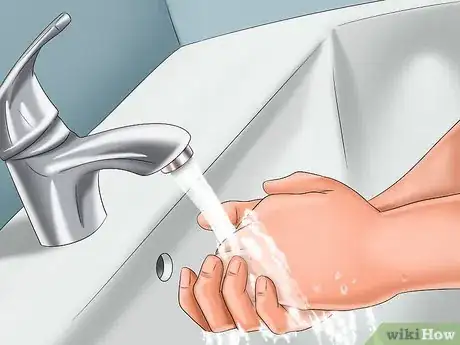
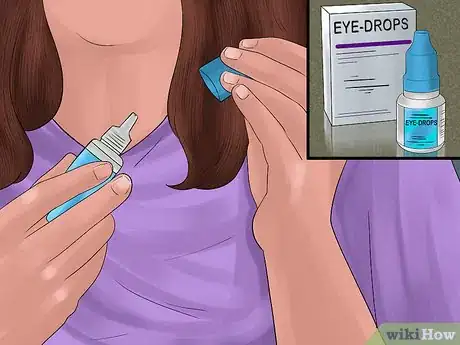
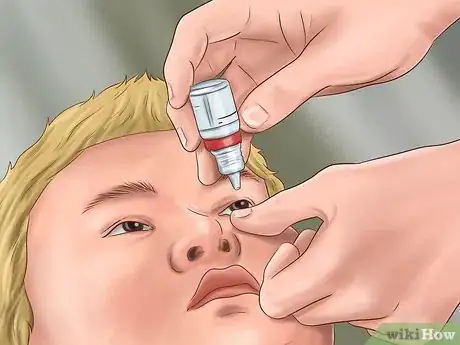
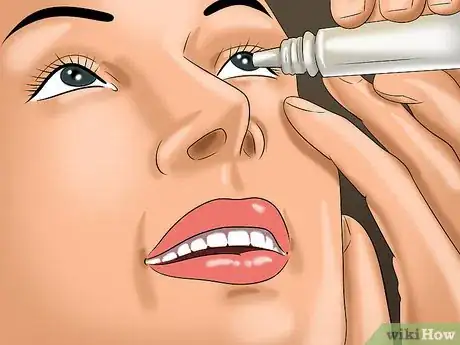
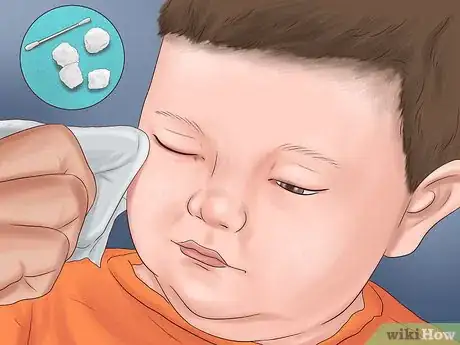
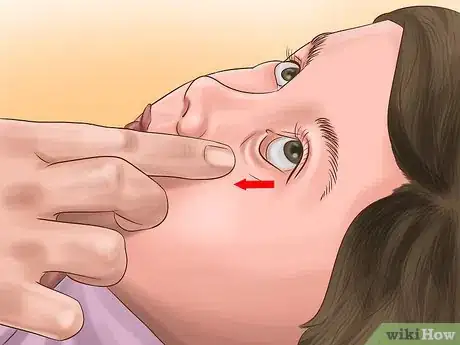
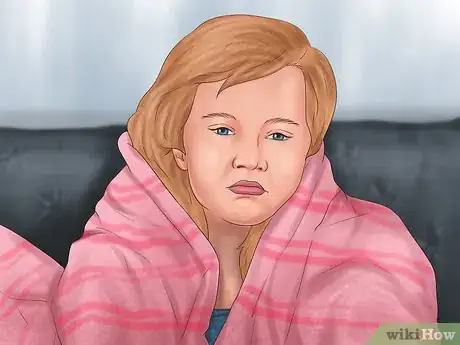
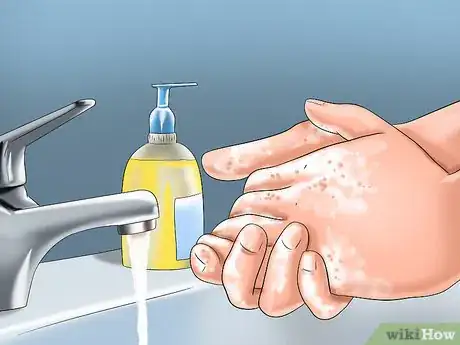
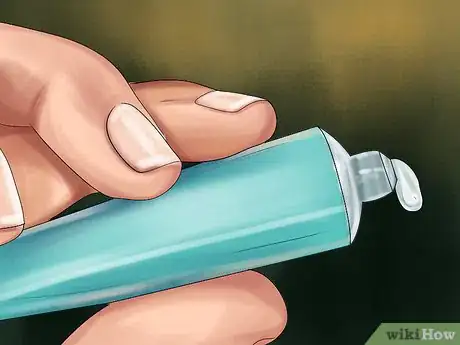



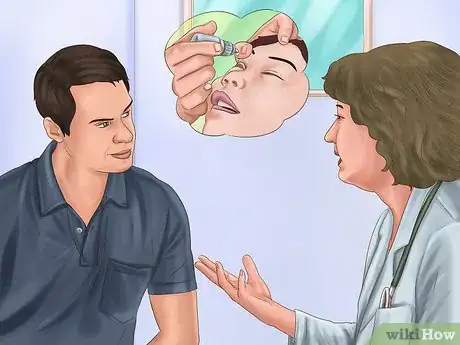
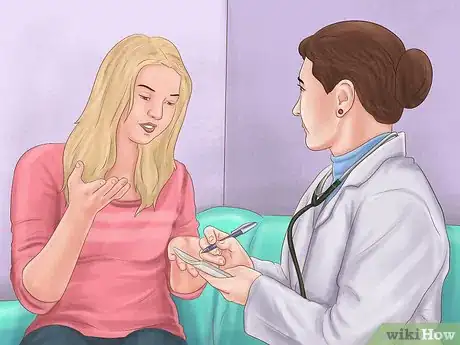
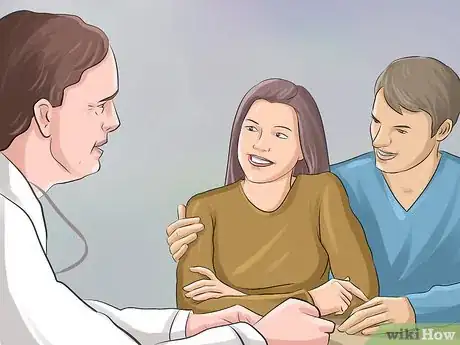

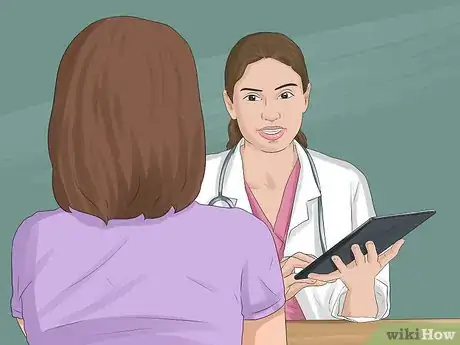
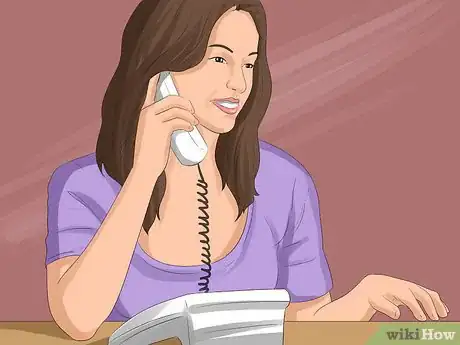

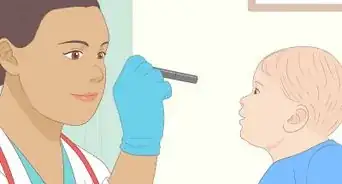
-Step-3-Version-2.webp)
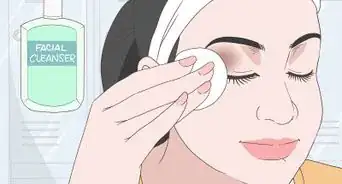

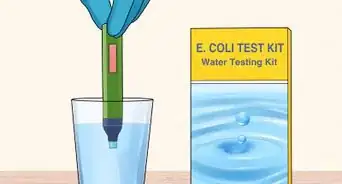


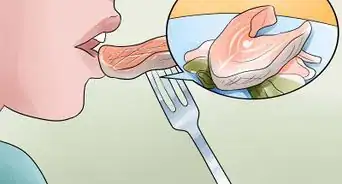

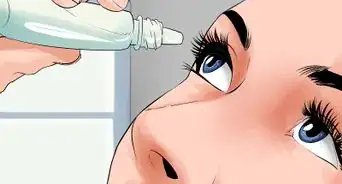







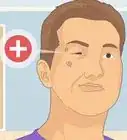

-Step-3-Version-2.webp)



































Medical Disclaimer
The content of this article is not intended to be a substitute for professional medical advice, examination, diagnosis, or treatment. You should always contact your doctor or other qualified healthcare professional before starting, changing, or stopping any kind of health treatment.
Read More...